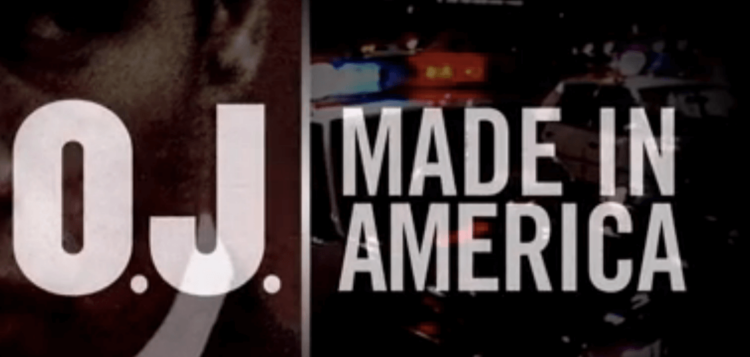
In June 1994, when I was 19, NFL football star and national hero, O.J. Simpson was accused of murdering his ex-wife and her friend, Ronald Goldman. It was international news and the trial and subsequent acquittal in 1995 – despite a mountain of evidence – stunned the nation. It was one of the first trials to be broadcast on television and undoubtedly changed how the media interacts with legal cases.
To some people, the O.J. case was just a bunch of celebrity nonsense and many people wanted nothing to do with it then and they don’t care about it now. I felt the same way then; I didn’t follow the trial and honestly didn’t even know the details of what happened to him after the trial.
But after two close family members told me to watch “O.J. Simpson: Made in America,” ESPN’s new five-part docuseries about O.J., I decided to watch. What I was told is that the docuseries is not about O.J. – I mean, it IS about O.J… But that’s not what it’s really about. What it’s really about is the climate of the treatment of black people in this country and how Simpson’s lawyers used the police force’s history of mistreatment of black people as motivation for the jury – which included 8 black people – to acquit him.
That O.J. beat his wife while they were married was already public knowledge – police had been called to their home 8 times before the 9th call led to Nicole being hospitalized for injuries as a result of him beating her. The climate of the 1990s around the issue of domestic violence led to these violations being largely swept under the rug; O.J. pleaded no contest and had some counseling sessions with a therapist over the phone and that was the end of it.
Except that wasn’t the end of it. Nicole was brutally murdered. Her ex-husband had threatened to kill her numerous times, and his blood was found all over the crime scene. A glove was found at the scene of the crime and a matching glove was found at Simpson’s home. He had no alibi for the time of the murder. He fled arrest, leading cops on an elaborate and quite ridiculous car chase on the freeway and he threatened to kill himself before finally turning himself in. And all of that was before the drama of the criminal trial began.
After O.J. was acquitted, he was found guilty in a civil trial, an ‘easier’ case to fight than a criminal one because the burden of proof is lower, and he was required to pay upwards of $30 million to the Goldman family. It was considered a win for the victims, but O.J. was still assumed innocent by many in the black community, and to this day, the statistics skew towards whites believing he was guilty and blacks thinking he was innocent (although the percentage gap between black and white Americans has closed according to this poll from the Washington Post).
After the civil trial, O.J. returned to a very public life of partying and drinking with strippers and being photographed in all sorts of undesirable situations. In 2008, he was accused of attempted kidnapping and a bunch of other charges after storming a hotel room in an attempt to retrieve some of his old sports memorabilia, which he had sold in his efforts to pay damages to the Brown and Goldman families. The incident was caught on tape and he was sentenced by a Nevada judge to 33 years in prison and that’s where he is now. He is eligible for parole next fall.
Whether or not you think O.J. did or didn’t kill Nicole Brown Simpson and Ronald Goldman is not the point and it’s not why you should watch the series. You should watch the series because it details very specifically how the racism-related problems we are seeing throughout this country – especially the mistrustful and emotionally fraught relationship between African-Americans and law enforcement – which are playing out on the streets of our cities weekly did not start in the past decade or two. Those problems started a very long time ago, before O.J. was even born.
This series takes you through the history of Los Angeles from the years where black people were first populating the city through the Watts riots. Then we see the Los Angeles O.J. lived in when he was a student at USC and an NFL-hopeful. And we see the Rodney King beating, in which a defenseless, unarmed black man who was not resisting arrest was beaten with batons while lying on the ground for about 10 minutes. A year later, the trial of the four officers caught on tape was held in a suburb of Los Angeles that was home to a very large population of white police officers and the acquittal of police officers who should not have been acquitted led to rioting all over the city.
Those riots looked a lot like the Watts riots. And in this docuseries, you see the parallels to the riots we are seeing now and have been seeing for the past few years because of the deaths of black people and the lack of accountability on behalf of many on the police force and by the judicial courts in this country.
The O.J. series shows how his lawyers capitalized on the abuse of black men and the insinuation that the white police officers involved in the case were racists – one of O.J.’s lawyers even invoked Hitler when discussing one of the cops involved in the case. The details of the murders are grisly, but fascinating, and it is truly unbelievable that O.J.’s lawyers were allowed to show jurors O.J.’s home only after they took down all of the pictures of him with his rich white friends and replaced them with pictures of him with black leaders; even adding artwork depicting black individuals breaking the race barrier which were not ever hung in O.J.’s home. By doing those things, his legal team transformed O.J. – who had enjoyed financial and social privilege unavailable to most black Americans – into a victim of white police brutality, when that was not what the Simpson-Goldman murders were about. That they were able to do this successfully speaks to the climate of race in America at the time. Seeing the historical context for this trial blew my mind, and speaks to the larger climate of flawed justice that shaped this case.
And what stuck with me after watching these five episodes is how much of the history of this country is repeating itself. And how many white people just don’t understand or want to understand and acknowledge that. When GrokNation first started, I wrote about my friendship with a man named Melvin. Melvin was the person in my life who made the conflict of black people in this country so clear to me. As discussed in my post, Melvin said that if we keep seeing the same problem over and over and over again, it means we didn’t fix it right the first time. Well, I’m sorry to say that we have not fixed this problem.
The O.J. docuseries made that so clear to me yet again: the mistreatment of black people in this country – in many cases by people who happen to wear a uniform – is prevalent. It is evil and it is unacceptable. There are so many wonderful police officers who risk their lives every day to protect us and for them I am grateful, and I know you are, too. But where there is racism and where there is bias we can no longer stand silent. There will always be a margin of error and sometimes there are tragic mistakes that any good police force will be forthcoming about, apologetic for, and responsible for.
But the institutional racism that has pervaded this country touches every line of work, and police are not immune. The footage in the O.J. docuseries of police mistreating and abusing unarmed black men 60 years ago is not that different from what we see now. It is a source of shame for me as a person with white privilege to see that. And it is a constant source of outrage that in 2016, we are still seeing it happen.
Watching this docuseries is important, not necessarily to learn about the O.J. case, but because it gives you an interesting and compelling framework to understand not only why O.J. was found innocent in the first trial, but why a culture of fear about police officers because of consistent abuse and racism and mistreatment leads to a culture of more fear and rage and hatred. Today, Black Lives Matter as a movement has been criticized for not having enough of the right kind of leadership and for not doing things perfectly. I can’t speak to that, and I don’t always agree with how they go about things, but they are trying to make clear in a very distinct way that we have a cycle that is repeating itself and that it is unacceptable for it to continue.
I pray that we are almost done with this phase of it. We are trying to all find our way through this mess, but I think a great way to start – especially for people who are not black – is to watch this documentary and learn about why things look the way they do today.
This problem we have did not spring up overnight. And it won’t go away overnight. But educating ourselves about how we got where we are, and removing the denial about what this situation is, I think, is one of the best gifts we can give ourselves if we want to believe in a country that judges people not by the color of their skin but the content of their character.




 Read More From Mayim
Read More From Mayim
Grok Nation Comment Policy
We welcome thoughtful, grokky comments—keep your negativity and spam to yourself. Please read our Comment Policy before commenting.